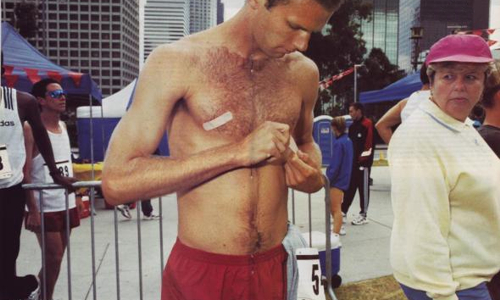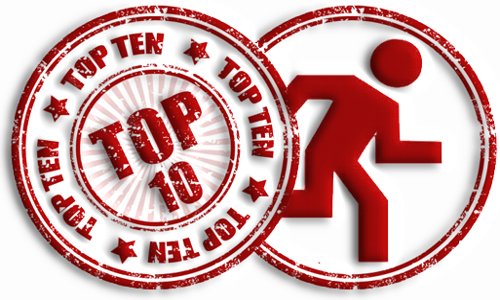Top 10 embarassing running problems

Running is good for you, fact. Running gives your heart muscle an effective work out and improves your circulation, helps you stay in shape and strengthens your bones. However, all runners will know that there is a dark side to running. Oh yes. A leaky bladder, runner's trots and bloody nipples are all things to expect when you start pounding the pavements regularly. Here we list the Top 10 embarrassing runner's problems.
10. Excessive sweating - Whilst it may be embarrassing sometimes, sweat is actually runner's best friend. Perspiration is our natural means of coping with body heat; the more we move the more we heat up and the more we sweat. As you become more highly trained, you become more efficient in cooling your body through sweating; well-trained athletes actually sweat more than amateurs. Runners should make sure they wear the right clothing to help deal with excessive sweating. When it comes to running, cotton is Enemy No. 1, absorbing heat and moisture and keeps it clinging to your body like a wet rag. Good running clothing will "wick" moisture away from the body to the outside, keeping you comfortable and dry.
9. Acne - Acne on the upper back, chest and upper arms is common for runners. When you run, the sweat combined with friction from your rubbing clothes can clog your pores, causing unsightly spots. Women often experience this more, and pimples can be prevalent around clothing covered skin like under their sports bra. The best way to deal with runner's acne is to shower immediately after a run and cleanse acne prone areas thoroughly. Make sure you change out of any sweaty clothes as soon as possible - sitting around in them will just intensify the problem!
8. Itchy legs - Itchy legs are a common and annoying problem for runners, particularly beginners. Inside our muscles are millions of tiny capillaries and arteries which expand rapidly during exercise due to demand for more blood. When fit, the capillaries open allowing maximum blood passage, but these tend to collapse when you are inactive. The rapid expansion of capillaries causes nerves to send impulses back to the brain, which are interpreted as an itch. Quite simply, the more you run the more your itching will subside. And whatever you do, don't scratch! It will only make the itching worse.
7. Rashes - Heat rash, prickly heat and miliaria rubra are commonly experienced by runners when their sweat glands become blocked or over-stimulated and can't release perspiration. Heat rash can be exacerbated by friction, tight clothing and hot weather. Make sure you wear comfortable, running clothes that wick moisture away from your skin, and shower as quickly as you can after a run to lower your surface temperature.
6. Jogger's nipple - Jogger's nipple is a common problem for runners, particularly men. The nipples are formed from delicate tissue, and as you run your clothing can rub against them causing irritation, dryness, inflammation and even bleeding. Men suffer particularly with jogger's nipple because they are not protected by sports bras. Wearing the right clothing will help prevent sore nipples. Women should protect themselves with a well-fitting sports bra, and men could use a plaster or surgical tape to protect their nipples from their outside clothing. Barrier creams like Vaseline can also be used to great effect.
5. Chafing - Other areas of your body can also suffer from chafing when running, particularly around the groin or inner thighs. The most common symptom of chafing is a painful stinging or burning sensation, and the area is usually red and raw. The no cotton rule applies to underwear when running. Tight fitting, synthetic underwear will wick away moisture and help to prevent chafing. Some runners even prefer to run without any underwear on at all - whatever works for you!
4. Clicking joints - Many people have joints that click when they run, and as long as there is no pain with the clicking then there is usually nothing to worry about. But if you are experiencing pain with your clicking joints then it could be that you are "out of alignment" in some way. If you have private medical insurance then it could be worth getting your physiotherapist to take a look at you, or go to your doctor to be referred to one. You may be flat footed or have one leg longer than the other, which may be causing your joints to work inefficiently.
3. Black toenails - Black toenails are a common affliction of many runners. If a toe is under pressure from the shoe or a sock that is too tight, the sustained pressure damages the tissue around the toenail - the black toenail is a result of the broken blood capillaries. The nail will usually fall off when a new nail eventually grows in. To prevent black toenails, make sure you are wearing a correctly fitting running shoe, trim your toenails regularly, and wear wicking socks rather than cotton ones. If you do suffer a black toenail, leave it alone as it will heal in its own time. However, if you notice any redness or infection, then see your doctor.
2. Leaking bladder - Leaking urine when you run may feel embarrassing, but it is actually more common than you might think, particularly in women. Its official term is "exercise-induced urinary incontinence", and 30%-40% of women have experienced it to a point where it bothers them. Exercise-induced incontinence is more common as women age, and also more common in women who have given birth. Kegel exercises can help strengthen the pelvic floor muscle and may help with mild bladder leakage. However, anyone who is worried about it should visit their doctor, who will be able to offer advice and treatment for the condition. Some health insurance policies even offer cover for private bladder treatments and surgery.
1. Runner's trots - Whatever you want to call it, diarrhoea is a major concern for many runners - around 20% to 50% suffer from "runner's trots"! The causes of runner's diarrhoea remain under debate, but it is thought that running alters intestinal hormones. Runner's diarrhoea will normally clear up by itself from several hours to two days after running, but make sure you replace lost fluids by drinking plenty of water. Your diet can create the problem, but medical issues like irritable bowel syndrome can make it worse. It can be worth keeping a food diary to see how your diet affects your bowel movement. When all else fails, consult with your doctor about taking anti-diarrhoea medicine, such as Imodium, one hour before an important run.
Credits - WorldwideRunning.com would like to thank Articles Base for the permission to reprint the article "Top Ten Embarrassing Running Problems" by Chloe Hibbert. Chloe Hibbert writes expert articles on health and the medical insurance industry for ActiveQuote.com.
 | Running Top 10 - From the top ten reasons to run to the top ten reasons *not* to run, this section includes both serious and humorous running lists for all walks of life. |

